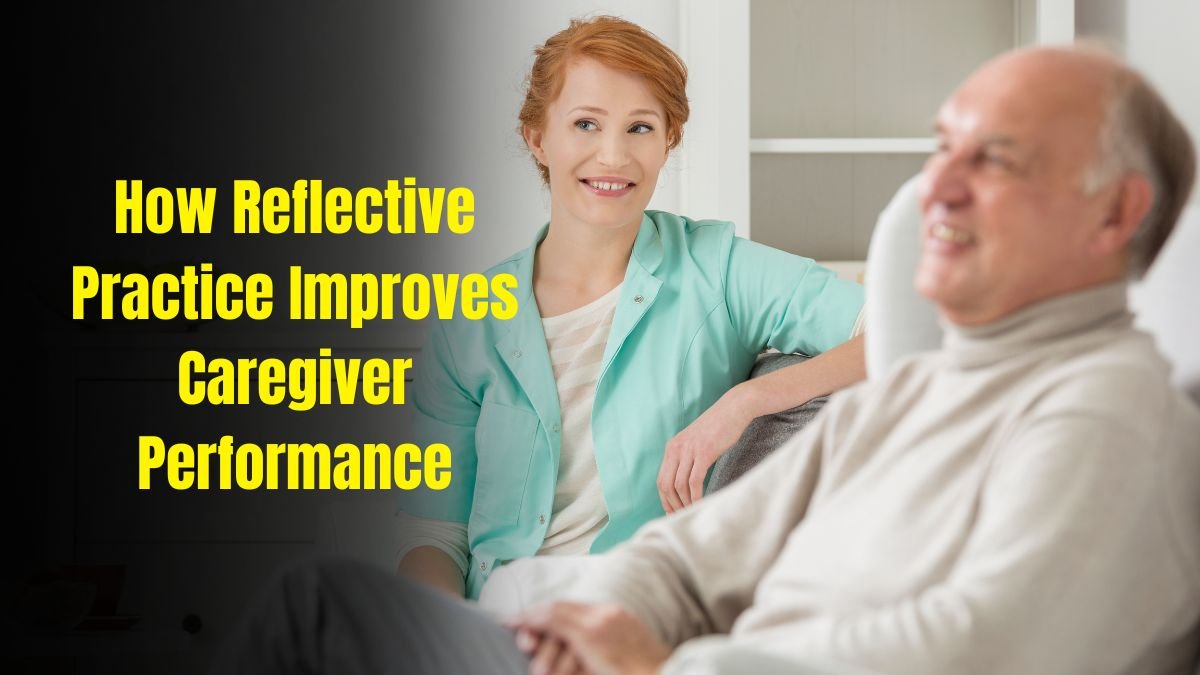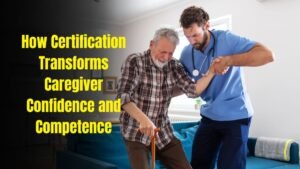In the demanding world of caregiving—whether in healthcare, home care, elder care, or disability support—continuous improvement is not optional, it’s essential. One powerful method for driving improvement is reflective practice.
Reflective practice refers to the deliberate process of thinking critically about one’s actions, decisions, and experiences, to learn and adapt for the future.
In recent years, research from nursing, social care, and allied health fields has increasingly demonstrated that reflective practice can enhance caregiver competence, boost empathy, reduce burnout, and ultimately elevate care outcomes.
What Is Reflective Practice?
Reflective practice is more than casual introspection. It is a structured, intentional, analytical process through which practitioners examine their actions, emotions, assumptions, and outcomes in order to learn and adjust.
Key Concepts & Models
- Reflection-in-action: Thinking while doing—adjusting one’s approach during the activity itself.
- Reflection-on-action: Retrospective thinking after the activity—evaluating what happened, why, and how to do better next time.
- Double-loop learning (Argyris & Schön): Going beyond fixing a single error (single-loop) to reexamining underlying assumptions, goals, and frameworks.
- Various structured reflective models: e.g. Gibbs’ Reflective Cycle (Describe → Feelings → Evaluation → Analysis → Conclusion → Action Plan), Borton’s “What? So what? Now what?”, Brookfield’s four lenses, etc.
These models provide scaffolding for caregivers to move from mere recall to deeper insight, learning, and behavioral change.
Why Reflective Practice Matters for Caregivers
Caregivers operate in complex, emotionally charged, and often unpredictable environments. Reflective practice offers multiple benefits:
- Improved decision-making & judgment
Reflective practice helps caregivers analyze choices and consequences, reduce errors, and adapt care strategies. - Enhanced self-awareness, empathy & emotional regulation
Reflection fosters recognition of one’s biases, emotional responses, stress triggers, and interprofessional dynamics—leading to more compassionate and mindful caregiving. - Reduced burnout and improved well-being
Among nursing students and practitioners, reflection has been shown to decrease anxiety and negative emotions, helping build mental resilience. - Bridging the theory–practice gap
Caregivers often receive academic or procedural knowledge, but applying it in real contexts requires adaptation. Reflective practice helps integrate theory with lived experience. - Continuous professional growth & competence
Reflective learning supports ongoing development, helping caregivers evolve rather than stagnate. - Better caregiver–client relationships and outcomes
As caregivers become more self-aware and responsive, quality of care improves, communication improves, and client trust strengthens.
Evidence & Figures: What the Research Shows
Below is a summary table of key studies and their findings related to reflective practice in caregiving, nursing, and allied health sectors.
| Study / Year | Context / Population | Major Findings & Figures | Implications for Caregivers |
|---|---|---|---|
| Yang et al. (2025) | Nursing students | Reflective practice enhances empathy and compassion development. | Shows that caregivers in training can internalize reflective habit early. |
| Bowers et al. (2025) | Nursing education | Reflection reduces negative emotions and anxiety, supporting confidence. | Reflective practice can bolster mental well-being in caregivers. |
| Mohajer et al. (2024) | Geriatric nursing interns | The holistic reflective learning program significantly improved professional competency (versus conventional methods). | Structured reflection training produces measurable gains. |
| Mohamed et al. (2024) | Nurses in clinical settings | Reflection correlated positively with stronger clinical skills, decision making, and self-regulated learning. | Reinforces value of reflection in practice environments. |
| Lorio et al. (2021) | Caregiver coaching / early intervention | Analyzed reflective conversational turns; classified into objective, interpretive, critical types; reflected that embedding reflection yields richer dialogues. | Helps caregivers and supervisors understand how to reflect rather than just that to reflect. |
| Evaluation of RPI (2025) | Pediatric critical care caregivers | Reflective Practice Intervention (RPI) improved reflective abilities and perceived care quality among caregivers. | Demonstrates the effectiveness of deliberately designed reflection programs. |
These studies collectively confirm that well-implemented reflective practices yield measurable benefits in competence, emotional resilience, empathy, and care quality.
How Reflective Practice Improves Caregiver Performance: A Mechanism View
To understand the “how,” let’s break down the pathways by which reflection leads to performance gains:
- Metacognitive Awareness & Self-Monitoring
Through reflection, caregivers become more aware of their thinking, assumptions, blind spots, and emotional states. This metacognitive insight allows them to monitor and adjust in real time. - Critical Thinking & Problem Framing
Reflection encourages critical evaluation of past decisions and reframing challenges. Instead of doing the same “fix,” caregivers learn to question underlying premises (double-loop learning). - Feedback Integration
Reflective practice often involves integrating feedback (from clients, peers, supervisors) and contrasting it with one’s self-perception, leading to better alignment and growth. - Action Planning & Experimentation
Reflection should culminate in a concrete action plan (what to try differently next). This translates insight into altered behavior. - Iterative Learning Cycle
Reflection fosters a cycle: action → reflection → revised action → deeper reflection. Over time, this growth spiral enhances expertise. - Emotional Regulation & Resilience
By acknowledging emotional responses, caregivers can process stress, frustration, or guilt constructively—reducing emotional exhaustion, which in turn sustains performance quality. - Empathy & Relationship Awareness
Reflecting on interactions helps caregivers see from the client’s perspective, improve communication, adjust tone, and repair relational missteps. - Reduced “Habitual Practice” and Blind Spots
Without reflection, caregivers may fall into routine, following protocols unthinkingly. Reflection surfaces these habits, inviting innovation and avoidance of stagnation.
Practical Strategies for Embedding Reflective Practice
To make reflection an active force—and not just theory—caregivers and organizations can adopt several best practices:
1. Reflective Journaling / e-journals
Writing regularly (daily, weekly) about experiences, emotional reactions, dilemmas, and lessons helps concretize thinking. Some apps or digital journals provide prompts for “What went well?”, “What challenges?”, “What I’ll change next?”
2. Structured Reflection Models
Use frameworks like Gibbs’ cycle, Borton, or John’s reflection model to guide the process systematically, ensuring critical elements aren’t skipped.
3. Peer Reflection / Reflection Groups
Meeting with colleagues to share cases, reflect together, compare perspectives, and provide feedback fosters collective learning and avoids isolation.
4. Supervisor / Mentor Reflection Sessions
One-on-one reflective dialogue with a supervisor or mentor encourages deeper insight, accountability, and coaching.
5. Video-based Reflection / Video Review
Recording care interactions (with consent) and reviewing them can surface nonverbal cues, missed opportunities, communication gaps. Video-based reflection has been shown to produce more focused critique than memory-based recall.
6. Critical Incident Analysis
After a challenging or significant event (e.g., error, conflict, breakthrough), schedule structured reflection to explore factors and lessons.
7. Use of Reflective Prompts
Incorporate short prompts (e.g. “What surprised me today?”, “What assumptions did I bring?”, “What would I do differently next time?”) during or after shifts.
8. Technology-Assisted Reflection
Some AI / analytics tools (e.g. TeamVision) support reflection from simulation or recorded data by summarizing key interaction metrics, spotlighting moments to reflect.
9. Embed Reflection in Organizational Processes
Make reflective time and routines part of shifts, debriefs, quality improvement cycles—rather than ad hoc.
10. Training & Workshops on Reflection Skills
It’s insufficient to tell caregivers to “reflect”—they need scaffolding, modeling, and practice. Training programs that teach types of reflection, reflective prompting, and meta-reflection are more effective.
Common Challenges & How to Overcome Them
| Challenge | Consequence | Mitigating Strategy |
|---|---|---|
| Time constraints & workload pressure | Reflection gets skipped or superficial | Allocate protected reflective time; integrate reflection into workflow (e.g. short end-of-shift prompt) |
| Fear of judgment or vulnerability | Caregivers may avoid honest self-examination | Create psychologically safe environments; use confidential or guided reflection approaches |
| Lack of reflection skills | Reflection becomes shallow or circular | Provide training, scaffolding, templates, and mentor support |
| Poor structure / randomness | Reflection lacks depth, consistency | Use structured models, prompts, and periodic review |
| Not converting insight into action | Reflection becomes intellectual but not behavioral | Always include explicit action planning and follow-up review |
| Isolation (no peer discussion) | Perspective is limited | Encourage group reflection, peer review, case forums |
Implementation Example: A Sample Reflective Workflow
Here’s a weekly reflective schedule caregivers might adopt:
| Day | Reflective Activity | Focus / Prompt |
|---|---|---|
| Monday start | Quick pre-shift reflection | “What is my intention this week? What might challenge me?” |
| Midweek (Wednesday) | Journal entry or peer reflection | “What’s going well? What’s not? What surprised me?” |
| Friday end | Critical incident reflection | Pick one complex case; apply Gibbs / prompt to analyze and plan next steps |
| Supervisor session (biweekly) | Mentor-coach reflection | Discuss one case, one personal insight, and feedback |
| Monthly group session | Peer case reflection | Rotate case presentations and collective reflection |
Over a year, this iterative structure builds depth, habit, and sustained improvement.
Illustrative Case Example (Hypothetical)
Scenario:
A caregiver (Alice) cares for an elderly patient with dementia. One day the patient becomes agitated and refuses medication, leading to conflict.
Reflection using Gibbs’ cycle:
- Description: The patient screamed, resisted taking pills, caregiver raised voice, patient worsened.
- Feelings: Frustrated, stressed, worried about harm; felt guilty about raising voice.
- Evaluation: The approach escalated conflict; lack of patience and alternative strategies.
- Analysis: Possibly triggers: the caregiver ignored subtle cues of distress, rushed routines, didn’t pause to explain. The caregiver’s emotional fatigue reduced patience.
- Conclusion: Could have paused, offered choice, explained rationale gently, used calming protocol.
- Action Plan: Next time, slow down, use empathy statements (“I see you’re upset”), ask patient preference, pause for breathing, de-escalate verbally.
After applying this plan, Alice notes the second time the patient complied more easily, and the episode was shorter and calmer.
Over months, such reflection sharpens her anticipatory sensitivity, patience, and adaptability.
Measuring the Impact of Reflective Practice
To ensure that reflective practice is not just a feel-good exercise but yields real gains, organizations and caregivers can track metrics such as:
- Self-assessed competence / confidence surveys (pre- vs post-reflection training)
- Empathy / attitude scales
- Number of adverse incidents or errors over time
- Client satisfaction / feedback ratings
- Burnout / emotional exhaustion instruments
- Supervisor assessments of care quality changes
- Rate and depth of reflective entries / reflections logged
- Observed behavior changes (e.g. fewer conflict escalations)
For example, in one reflective practice intervention (RPI) in pediatric care, caregivers reported improved perceived care quality after the program.
Reflective practice is far more than “thinking about your day.” It is a rigorous, evidence-based pathway toward continuous improvement, deeper empathy, enhanced decision-making, and sustainable caregiver performance.
The latest research—from nursing education to caregiver coaching—demonstrates that when structured well, reflection can reduce negative emotions, increase competence, and elevate the quality of care.
By adopting structured models, journaling, peer and mentor reflection, video review, and embedding reflection into routines, caregivers can transform experience into insight, insight into action, and action into progressive mastery. In the high-stakes, human-centered domain of caregiving, reflective practice is not optional—it’s essential.
FAQs
How often should caregivers engage in reflective practice?
Ideally regularly—daily for micro reflections, weekly for deeper journaling, and monthly or biweekly for guided reflection or peer sessions. Embedding reflection into routines ensures consistency.




